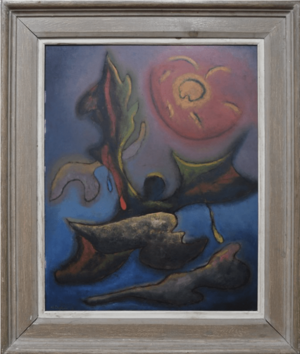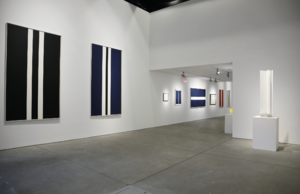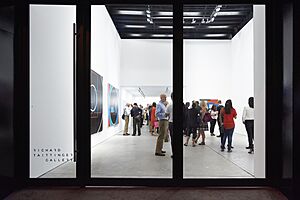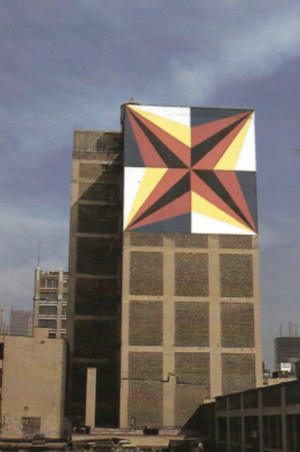Nassos Daphnis facts for kids
Quick facts for kids
Nassos Daphnis
|
|
|---|---|
 |
|
| Born | July 23, 1914 Krokeai, Greece
|
| Died | November 23, 2010 (aged 96) |
| Nationality | Greek-American |
| Known for | Painting, Sculpture, Tree Peonies |
| Movement | Geometric abstraction, Hard-edge painting |
Nassos Daphnis (born July 23, 1914, in Krokeai, Greece – died November 23, 2010, in Provincetown, Massachusetts, U.S.) was a talented artist. He was born in Greece but became an American citizen. Nassos Daphnis was known for his abstract paintings and sculptures. He also had a special hobby: he bred beautiful tree peony flowers.
Contents
Army Service: 1942–1945
Nassos Daphnis served in the United States Army from 1942 to 1945. During his time in the army, he used his painting skills in a unique way. He created camouflage patterns for large military maps. Camouflage helps things blend in so they are hard to see. Some art experts believe that working with camouflage helped Daphnis develop his later painting style. This style was known for its flat, clear shapes in his abstract art.
Education and Training
Nassos Daphnis is mostly seen as an artist who taught himself. However, he did get some formal art training. After his time in the military, Daphnis studied at the Art Students League of New York. From 1949 to 1951, he continued his art studies in Paris, France. He then studied in Florence, Italy, from 1951 to 1952. He even went back to Paris for a short time in 1952 to study more.
Biomorphic Paintings: 1945–1949
Nassos Daphnis's art style changed a lot over his career. He started by painting things realistically. After World War II, his art moved towards "biomorphic" shapes. These shapes looked like living things, often with a Surrealist influence. Surrealism is an art movement that explores dreams and imagination.
In 1947, Daphnis had an art show in New York City. It showed his biomorphic paintings and watercolors. An art historian named Gordon B. Washburn wrote about his work. He said Daphnis's art was becoming more organized and abstract.
In 1985, art critic Grace Glueck described these early works. She noted that Daphnis was also a hobbyist who bred new types of tree peonies. She said his paintings from 1947-48 showed organic, plant-like, and undersea forms. These works used bright colors and had a well-ordered structure. One painting, called Hybridization, showed plant leaves and stems. They were bathed in light and balanced shapes and colors beautifully.
Color-Plane Theory and Hard-Edge Painting: 1950s–2010
In the 1950s, Daphnis traveled back to Greece. There, the bright, clear sunlight changed how he saw buildings and shapes. They seemed simpler, like flat, geometric areas of pure color. After this trip, Daphnis created his "color-plane theory." He began to focus on geometric abstraction. This style uses simple geometric shapes. He used a limited color palette: only black, white, and primary colors (red, blue, yellow).
This became his unique style. These works are often called "Hard-edge" paintings. This means they have sharp, clear lines and flat areas of color. His style is often compared to Piet Mondrian, another famous artist. However, Daphnis saw Mondrian's ideas as a starting point, not the only way. Daphnis was also called an "abstract imagist." This term came from a 1961 art show in New York City where his work was featured.
In the late 1980s, Daphnis's style changed again. He started using new computer technology in his art. He also added a few more colors to his palette. Daphnis used computer-generated graphics and an Atari ST computer. He used them to create new digital landscapes. This showed he was ahead of his time in using New Media in art.
Gallery Representation
For almost 40 years, Nassos Daphnis was represented by the Leo Castelli Gallery. This gallery gave him 17 solo shows. They also often included his art in group shows with famous artists. These artists included Jasper Johns, Frank Stella, Robert Rauschenberg, and Andy Warhol. Castelli also helped Daphnis's work be shown in other galleries and museums. For example, in 1964, his painting EPX 28-64 was in an exhibition called "Art in Wood Today."
Later in his life, Daphnis also showed his art at the Eaton/Schoen Gallery and the Anita Shapolsky Gallery. In 2008, the Anita Shapolsky Gallery's "Masters of Abstraction" show included his work.
In 2015, the Richard Taittinger Gallery began representing Daphnis's art estate. He had his first solo show there, called Pixel Fields. His artwork was also in a group show called Ballet Mecanique. A magazine review discussed how Daphnis's work connected with other artists. It noted that both Daphnis and Mario Merz were influenced by World War II. They both explored how machines played a role in their art.
City Walls, Inc.
In 1969, Nassos Daphnis was asked by City Walls, Inc. to paint a large mural. This mural was on a wall at 26th Street and Madison Avenue in New York City. In 1971, he was asked to create another mural. This one was at West Side Highway and 47th Street. City Walls, Inc. installed public murals in New York City from 1971 to 1980. Sadly, neither of Daphnis's murals exists today.
Public Collections
Today, you can find Nassos Daphnis's artwork in many important public art museums. These include:
- Akron Art Museum, Akron, OH
- Albright-Knox Art Gallery, Buffalo, NY
- Baltimore Museum, Baltimore, MD
- Boca Raton Museum of Art
- Brooklyn Museum, New York
- Butler Institute of American Art, Youngstown, OH
- Carnegie Museum of Art, Pittsburgh, PA
- The Governor Nelson A. Rockefeller Empire State Plaza Art Collection, Albany, NY
- Guggenheim Museum, New York
- Hirshhorn Museum and Sculpture Garden, Washington, D.C.
- Jewish Museum of Florida
- Lowe Art Museum, University of Miami, Coral Gables, FL
- Macedonian Museum of Contemporary Art, Thessaloniki, Greece
- The Metropolitan Museum of Art, New York
- Museum of Modern Art, New York
- Provincetown Art Association and Museum, Provincetown, MA
- Reading Public Museum, Reading, PA
- RISD Museum of Art, Providence, RI
- Seattle Art Museum, Seattle, WA
- University of Michigan Museum of Art, Ann Arbor, MI
- Utah Museum of Fine Arts, Salt Lake City, UT
- Walker Art Center, Minneapolis, MN
- Whitney Museum of American Art, New York
Honors and Awards
Nassos Daphnis received many awards for his art, including:
- Arts Achievement Award, Queens Museum Art, New York (1999)
- Richard A. Florsheim Art Fund Award, U.S.A. (1992)
- The Pollock-Krasner Foundation Award, U.S.A. (1986)
- The Francis J. Greenburger Foundation Award, U.S.A. (1986)
- Guggenheim Fellowship, New York (1977)
- New England 350th Celebration Exhibition, U.S.A. (1972)
- National Endowment of the Arts Grant Award, U.S.A. (1971)
- Boca Raton Museum Award, Boca Raton, FL (1971)
- National Foundation of the Arts and Humanities Award, U.S.A. (1966)
- Pittsburgh Award (1966)
- Ford Foundation Award, U.S.A. (1962)
- Purchase Award: Painting donated to the Whitney Museum of American Art, New York (1962)
Tree Peonies
Nassos Daphnis was not only a great artist but also a successful breeder of tree peonies. He created about 500 new types of tree peonies! Forty-eight of these were officially named and registered. His interest in these beautiful flowers started in 1938. He met William H. Gratwick, who was also a famous tree peony breeder.
Daphnis eventually became partners with Gratwick. Together, they worked on hybridizing tree peonies. Hybridizing means creating new plant varieties by crossing two different types. They created many beautiful new cultivars (plant varieties). They often named them after artists and figures from Greek mythology.
In a 1984 interview, Daphnis talked about how he first fell in love with tree peonies. He described visiting Gratwick's garden in 1938. He saw rows of tree peonies in full bloom. He said their colors were "incredible." Even though he had worked in a flower shop for years, he had never seen flowers like these. He was fascinated by their beauty.
As a painter, his first thought was to paint portraits of each flower. He wanted to capture their beauty and elegance. He did paint some of them, but his work with the army soon took over.








